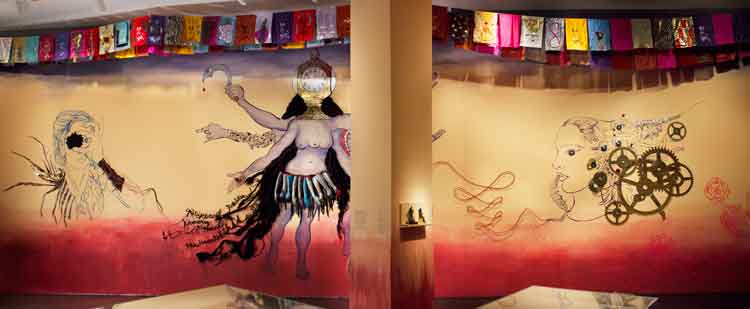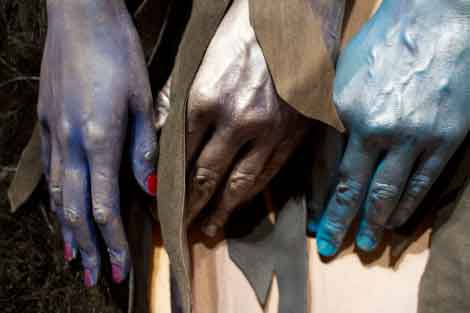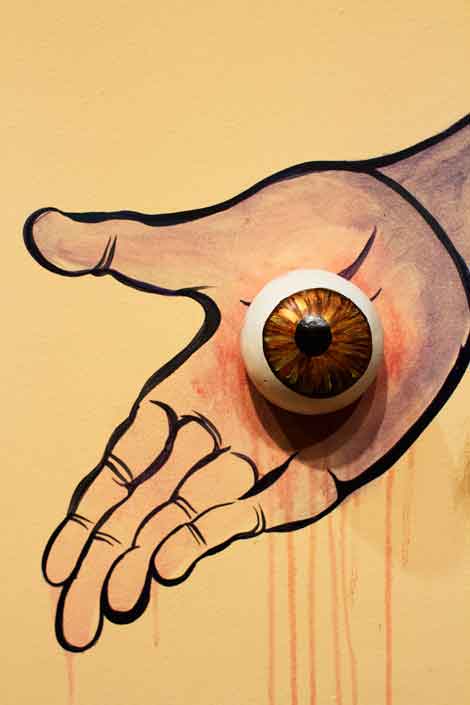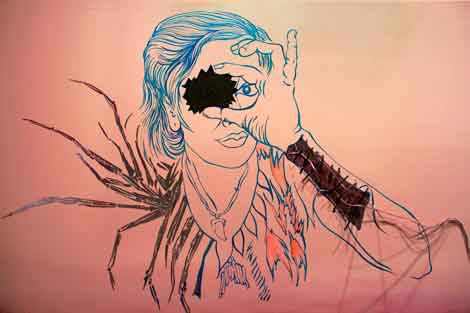Chitra Ganesh’s site-specific mural Eyes of Time at the Elizabeth A. Sackler Center for Feminist Art of the Brooklyn Museum recalls the Kitsch Movement of the ’90s. As the child of Indian immigrants living in New York, Ganesh’s art responds to the dearth of her native South Asian culture by formulating a language that is not curbed by precepts of any kind. She produces a multiplicity of voices that is deeply ingrained in her work as an expression of her individualism.
During a conversation at the museum with assistant curator Saisha Grayson, and the show’s organizer, the artist described the mash up of Eastern and Western influences, such as the Indian comic book series Amar Chitra Katha, Archie comics, Green Lantern and Max Ernst’s illustrations amongst other sources, which shaped her forms and characters.
Installed in the Herstory Gallery of the Sackler Center, Ganesh’s primary inspiration comes from Judy Chicago’s use of Kali the Indian goddess in her permanent installation “Dinner Party” at the Sackler Center, as well as influences from other artifacts by Louise Bourgeois, Kiki Smith and Soichi Ida in the museum’s collection. A semi-nude Kali, revered for her power of destruction to keep world order and her protection for those who seek knowledge, looms large. She is faceless, with a clock for a head. Six arms, one equipped with a sickle, and another with a large extra eye fixed to the palm, stretch outwards. A skirt made of severed arms cast from the limbs of a host of Ganesh’s friends hangs eerily from her waist, with lengths of artificial hair extending all over the wall.. Two futuristic-looking women—one fitted with computerized arms, the other ornamented by machine cogs—flank her on either side. A series of hand-embroidered flags at the top reference Ganesh’s neighborhood and other religions adorn the mural.
Combining different worlds of the East and West, old and new, tradition and modernity, with the past and the future, Ganesh forges a language of multiple references imbued by her experiences of being an outsider in a new world. The traditionally repulsive Kali and her cohorts come alive through the three dimensional quality of the sliced hands, thick black hair, and shiny cogs that incorporate campy images and materials from popular culture. Through these daunting figures that symbolize female empowerment, Ganesh continues her engagement with augmenting the significance of women.
However, by using one of the most popular deities from the pantheon of Indian gods, Ganesh’s work runs the risk of being clichéd as she embraces the exotic yet distinct, and outrageous but enticing qualities of the goddess. Although she contributes to the narrative of women’s recognition, Ganesh fails to convincingly subvert stereotypical conceptions of aesthetics, gender and race even as she dedicates her humanistic practice to women and reviving Indian culture.
Through July 12, 2015
Elizabeth A. Sackler Center for Feminist Art, Herstory Gallery, 4th Floor
Brooklyn Museum
200 Eastern Parkway
Brooklyn, New York 11238-6052
http://www.brooklynmuseum.org






